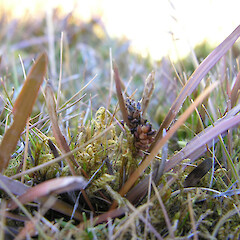Carex talbotii
Common name
Berggren’s sedge, Talbot’s sedge
Synonyms
Carex berggrenii Petrie (published in 1886) is deemed illegitimate because of the earlier named Carex berggrenii Heer (published in 1870)
Family
Cyperaceae
Flora category
Vascular – Native
Endemic taxon
Yes
Endemic genus
No
Endemic family
No
Structural class
Sedges
NVS code
The National Vegetation Survey (NVS) Databank is a physical archive and electronic databank containing records of over 94,000 vegetation survey plots - including data from over 19,000 permanent plots. NVS maintains a standard set of species code abbreviations that correspond to standard scientific plant names from the Ngä Tipu o Aotearoa - New Zealand Plants database.
CARBER
Chromosome number
2n = 60
Current conservation status
The conservation status of all known New Zealand vascular plant taxa at the rank of species and below were reassessed in 2017 using the New Zealand Threat Classification System (NZTCS) – more information about this can be found on the NZTCS website. This report includes a statistical summary and brief notes on changes since 2012 and replaces all previous NZTCS lists for vascular plants.
Please note, threat classifications are often suggested by authors when publications fall between NZTCS assessment periods – an interim threat classification status has not been assessed by the NZTCS panel.
- Conservation status of New Zealand indigenous vascular plants, 2017 . 2018. Peter J. de Lange, Jeremy R. Rolfe, John W. Barkla, Shannel P. Courtney, Paul D. Champion, Leon R. Perrie, Sarah M. Beadel, Kerry A. Ford, Ilse Breitwieser, Ines Schönberger, Rowan Hindmarsh-Walls, Peter B. Heenan and Kate Ladley. Department of Conservation. Source: NZTCS and licensed by DOC for reuse under the Creative Commons Attribution 4.0 International licence.
2017 | At Risk – Declining | Qualifiers: PD, Sp
Previous conservation statuses
2012 | At Risk – Naturally Uncommon | Qualifiers: Sp
2009 | At Risk – Naturally Uncommon
2004 | Sparse
Distribution
Endemic. North and South Islands. In the North Island restricted to the Central Ranges and Mt Ruapehu where it is known from one alpine flush (Ruapehu) and one site in the Moawhango. In the South Island mainly easterly from Lake Tennyson south. Apparently not known from Marlborough or Westland.
Habitat
A montane to subalpine (rarely lowland in the southern part of its range) wetland species inhabiting lake, tarn, pond, and stream side margins. It has also been collected from turfs bordering ephemeral wetlands.
Wetland plant indicator status rating
Information derived from the revised national wetland plant list prepared to assist councils in delineating and monitoring wetlands (Clarkson et al., 2021 Manaaki Whenua – Landcare Research Contract Report LC3975 for Hawke’s Bay Regional Council). The national plant list categorises plants by the extent to which they are found in wetlands and not ‘drylands’. The indicator status ratings are OBL (obligate wetland), FACW (facultative wetland), FAC (facultative), FACU (facultative upland), and UPL (obligate upland). If you have suggestions for the Wetland Indicator Status Rating, please contact: [Enable JavaScript to view protected content]
FACW: Facultative Wetland
Usually is a hydrophyte but occasionally found in uplands (non-wetlands).
Detailed description
Shortly rhizomatous, tufted dark purple red, wine-red, or orange red, tufted, small sedge. Culms 15–30 mm long, glabrous, terete, distinctly flattened above, almost completely enclosed by light brown leaf-sheaths. Leaves 30–60 × 1–2.5–3 mm, linear, concavo-convex, almost flat, nerves very distinct, margins not usually scabrid except towards the rather bluntly obtuse apex. Spikes 3–4–(6); terminal spike male, distinctly pedunculate; remaining spikes female, 5–8 mm long, ovate, sessile or shortly pedunculate, crowded at same level round base of male spike; leaf-like subtending bracts > inflorescence. Glumes rather < utricles, ovate, cuspidate, or entire and obtuse, membranous, red-brown with a paler brown midrib. Utricles 2–3 × 1.5 mm, biconvex or rarely subtrigonous, elliptic-oblong, turgid, red-brown to dark red-purple above, yellow below, distinctly nerved at first, smooth at maturity, margins glabrous; beak minute with the scabrid crura very shortly bifid to almost truncate; stipe 0.2 mm long, stout. Stigmas 2–3. Nut 1.5 mm long, trigonous.
Similar taxa
The remarkable broadly concavo-convex almost flat leaves with the distinctively bluntly obtuse leaf tips are unique to this species in New Zealand. Its nearest relatives would seem to be C. decurtata and C. hectorii. From C. decurtata, C. talbotii differs by broadly concavo-convex flat leaves which taper little (if at all) toward the obtuse tip and from C. hectorii by its purple red, wine-red, or orange red, broad obtuse tipped leaves. From both C. decurtata and C. hectorii, C. talbotii further differs by its utricle colour which is characteristically red-brown to dark red-purple above, yellow below, rather than light brown (C. decurtata) or dark brown (C. hectorii).
Flowering
October–February
Fruiting
October–June
Propagation technique
Easily grown in small pots doing best in pots that are partially submerged in water. Can be grown in a rockery, provided it is kept damp and free from competition. An attractive sedge which deserves to be more widely cultivated than it currently is.
Threats
A biologically sparse species which is not so much threatened as nationally uncommon. However, some populations are now at risk through competition from taller and faster growing wetland weed species.
Etymology
carex: Latin name for a species of sedge, now applied to the whole group.
talbotii: Named for Harry Talbot (1898-1982), a plant collector
Attribution
Description adapted from Moore and Edgar (1970).
References and further reading
Moore LB, Edgar E. 1970. Flora of New Zealand, Volume II. Indigenous Tracheophyta: Monocotyledones except Gramineae. Government Printer, Wellington, NZ. 354 p.
NZPCN Fact Sheet citation
Please cite as: de Lange, P.J. (Year at time of access): Carex talbotii Fact Sheet (content continuously updated). New Zealand Plant Conservation Network. https://www.nzpcn.org.nz/flora/species/carex-talbotii/ (Date website was queried)















